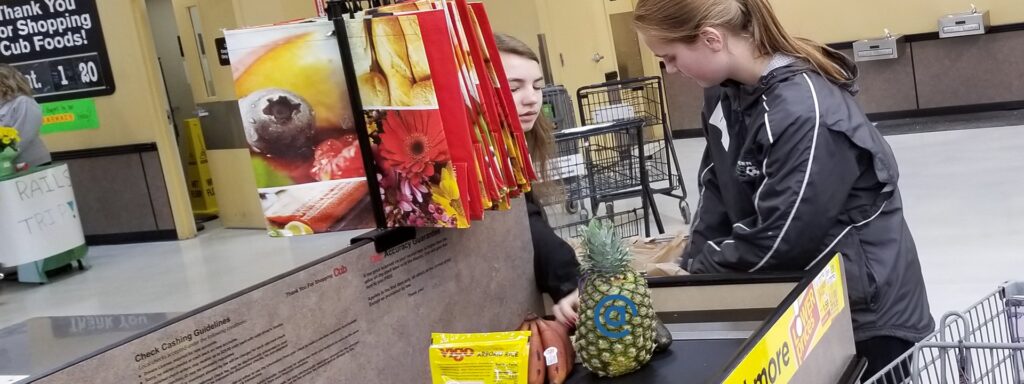“Paper or plastic sir?,” a pleasant, gently assertive female voice chimed from my right side peripheral vision. I’ve heard this phrase many times at the grocery store, completely familiar, baseline-communication, the fundamentals. “Paper or plastic” is a pure business expression. Let’s look at sheer functionality of the phrase, “Paper or plastic sir?:”Â
- Safe introductory greeting, completely appropriate for a grocery store environment, no surprise
- Easy to answer without thinking, paper or plastic, option A or option B
- Respectful, she called me sir, sounded confident and caring
- Simple to understand, clearly offering groceries bagging service
- Paper or plastic is a call to action which requires an answer to be socially acceptable. She maneuvered me into into a transactional corner. My options were something like paper, plastic, I brought own bags, please I don’t want my groceries bagged, no thanks, or I’m particular and like doing it myself. Anything less might be considered rude or obtuse.
Sounds like a simple story, right? Not really, there’s more here that meets the eye.. You see this grocery store does not employee baggers and there are no 12 year olds working at Cub Foods.  In fact Cub is a huge, slightly lower cost corporate DIY grocery store, a union shop.
Still, I answered the female voice with my bagging preference, plastic, without hesitation. Because the paper or plastic inquiry is such an common, engrained cultural question/response, I replied without nary a pause, “Plastic, please.”
Then, I realized these baggers were pre-teen, wearing youth soccer shirts from a nearby town and offering service as an unspoken, unrequested trade of their bagging for my donation. Yep, these were middle school soccer players, fundraising. Boom!
Turns out, I was in the hands of a couple of savvy preteen fundraising entrepreneurs. These two upstarts really got me thinking about marketing.
More often when fund raisers hit on someone in the grocery checkout line, the person bagging introduces her or himself with an interstitial statement like, “We’re fundraising for the Esko High School marching band trip to Disney, please can I bag your groceries?” That gives customers a moment of context to evaluate personal importance of of the cause at hand, an option to say yes OR an out to say no-thanks. If the customer’s response is “yes,” then comes the paper or plastic question. Step one, step two, tick tock.
As they started to bag items, I reached into my pocket handed one of them $5. I thanked the dynamic duo bagging my groceries and shared that both my daughters were captains of their respective varsity soccer teams
Marketing Fundamentals Learned From a 12 Year Old
This elegant exchange got me thinking about marketing. By skipping the typical introduction and cutting straight to a call to action, the baggers, selling me the donation, increased the possibility that I’d donate. They didn’t first ask yes or no, then paper or plastic. Instead these two cut right to the chase, paper or plastic. Here’s why their method is so effective, lessons we marketers can learn from children.
- Remove friction in the sales process. Asking paper or plastic first, assuming they’d be bagging my groceries, removed a good amount of friction. We skipped the yes or no decision and moved right along to my accepting their gift, donating or not.
- Infuse sales with service.  Lead with an unconditional gift not an entitled ask. Serving people before requesting favors is a winning marketing strategy, especially in social media.
- Give customers as many reasons as possible to say yes. As soon as I understood what was going on, rewarding these two was as much about tipping-for-bagging, as it was for supporting youth soccer.
- Be in-transaction from the start. That’s such a sophisticated premise and so simple. From the first few words, the youth soccer donation marketers had me already in-transaction.
- If your sale does not serve, leave prospective customers an out. For some people the bagger/donation scenario may be sensitive. My daughter sustained a massive injury playing soccer for years, which was devastating for my whole family. What if a Cub customer is in financial pain or in poor mental health. The youth soccer players, by not putting Cub customers on the spot, demonstrated a rare level of compassion in charitable gathering. It is oft said great marketers sell by serving the true needs of their target audiences. Remember to compassionately exclude those to whom your wares do NOT serve.
- Show up.  It’s a safe bet the young people I met today are kick ass soccer players. If they’re not physically gifted, I’m certain they make it up with leadership, energy and inspiration. These warriors show up and do it. The same holds true in business. You can’t hit a home run without stepping up to the plate.
- Act like you are supposed to be there. The youth soccer fundraisers just acted like they belonged and engaged Cub customers as per customary in other stores. The same holds true in business. Act like you belong until you do.
History teaches wisdom can be gained from the words and actions of young people. Apparently this timeless axiom applies to commerce. Today two 12 year olds naturally addressed basics and inspired a deeper clarity for this marketer. #Grateful.
21-Jan-18, Duluth









